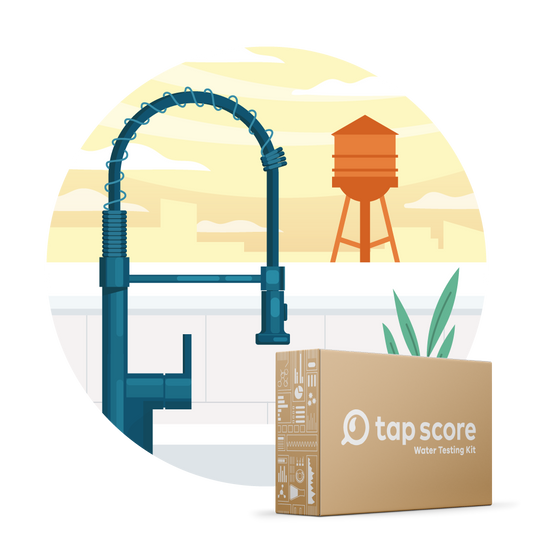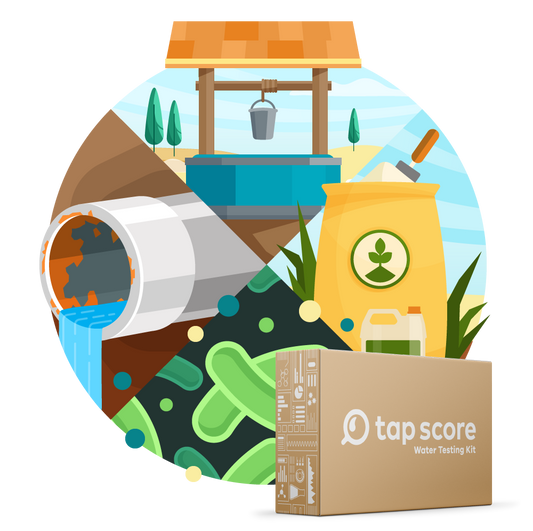
Wildfires & Water Quality: How Do Wildfires Impact Your Drinking Water?
Our blog is written by real experts— not AI. Each guide is carefully reviewed and updated based on the latest research. Plus, with no affiliate links, you can count on unbiased insights you can trust.
While wildfires are a natural part of most ecosystems, catastrophic wildfires can have far-reaching consequences on drinking water quality. Impacts on the water cycle can last for years, post-fire debris flows can flood water supplies with toxic runoff, and volatile organic compounds (VOCs) can be released from burnt buildings and other structures.
Our short guide on wildfires and water quality will give you insight into exactly how wildfires contaminate drinking water, what this means for your health, and what you can do to protect your drinking water after a wildfire.
Table of Contents:
- Is Tap Water Safe to Drink After a Wildfire?
- How Do Wildfires Impact Drinking Water?
- What Are the Health Risks of Drinking Tap Water After a Wildfire?
- How Do I Test My Water After a Wildfire?
- How to Protect Your Drinking Water After a Wildfire
- What’s the Takeaway?
Is Tap Water Safe to Drink After a Wildfire?
Consider all drinking water from close proximity to a wildfire to be chemically unsafe until proven otherwise. Wildfires can cause a variety of problems with water supplies that aren’t always straightforward to detect. If you are on city water, follow your utility’s guidelines as they communicate their activities around the fire.
How Can You Tell if Your Drinking Water Is Contaminated?
- Foul-smelling and/or discolored water
- Reduced water pressure
- Broken or leaking pipes, valves and hydrants
- Heat-impacted materials in/near your plumbing system.
Having your water tested (whether you’re on public water supplies or a private well) before resuming use is vital after a wildfire. Health agencies have struggled to perform sufficient water testing following major wildfires.
According to water quality experts, only testing can determine safety, and all buildings should be tested after a wildfire. Reliable testing also needs to include samples of both hot and cold water from many taps in a building because water quality can vary greatly between rooms.
Note: Most utilities are only responsible for testing the service lines up to the customer’s connection (typically at the curb box/water meter). Customers are responsible for testing the water quality in their homes after that.
Can Wildfires Contaminate Private Wells?
Absolutely, private wells are at risk of damage and contamination from wildfires. You should always test your well water after a fire, and particularly after changes in water appearance, smell and/or taste.
Contact a licensed well contractor if you see any of damage to:
- Electrical wires and connectors that supply power to your well
- The well casing and above-ground piping
- Chlorinators, water treatment equipment, and electronic controls
- Pressure tanks that could have been exposed to excessive heat
- Storage tanks, vents, and overflow pipes
Check for damage to plumbing inside your home by making sure the well system maintained pressure during the fire.[7] If you hear air escaping or see water sputtering while running a faucet, it is a sign that your well and household plumbing had a loss of pressure and may have been damaged.
If a well system is damaged during a wildfire, it may be at risk of contamination from chemicals and microorganisms. Likewise, fire retardant used near a wellhead can potentially contaminate the system, especially if the wellhead is damaged. Monitor ammonia and nitrate levels for several months.
If the fire reached the well, pressure tank, or any exterior plumbing including buried plastic piping, you should test for benzene.
How Do Wildfires Impact Drinking Water?
Depending on the duration and intensity of the fire, post-fire precipitation, local ecology, and watershed topography, wildfires impact drinking water by:
- Flooding water sources with ash, sediment, and nutrients
- Releasing toxic contaminants
- Destroying vital piping infrastructure
- Destroying private well infrastructure
- Overwhelming water treatment plants with vast quantities of impurities
These impacts can last for years after the flames subside, and can reach as far as 100 miles from the fire’s location. The worst of the effects occur within the first year or two following a fire; however, water quality changes may linger for nearly a decade.
How Do Wildfires Affect Water Supplies?
Wildfires can wreak havoc on water supplies and downstream aquatic ecosystems through a number of effects:
-
Erosion and runoff: One of the immediate effects of wildfires is the removal of protective vegetation, leaving soil exposed and vulnerable to erosion. Erosion may result in more downstream sediment accumulation. Increased runoff may change turbidity, nutrient content, and dissolved organic carbon (DOC) concentrations in drinking water supplies.
-
Changes in sediment load: Due in large part to erosion and runoff, sediment loads may increase rapidly and stress the capacity of a water treatment system or otherwise damage reservoirs and treatment plants. Sediment often carries other pollutants—especially phosphorus—which easily bind to sediment particles.
-
Changes in DOC: Increased sediment loads (detailed above) allow for increased dissolved organic carbon (decomposed plant or animal matter dissolved in water) in water sources. This matter reacts with the disinfectants present in treatment processes (e.g. chlorine) and can lead to an increase in harmful disinfection by-products (DBPs).
-
Elevated nutrient levels: Wildfires release nutrients from burned vegetation into water bodies, which can lead to increased nutrient levels—particularly nitrogen and phosphorus. These elevated levels can contribute to water quality issues, such as algal blooms, which produce harmful toxins that can further jeopardize the safety of drinking water.
-
Increased nitrate concentrations: Following a significant fire, nitrate concentrations often exceed the federal drinking water standard of 10 PPM. Surface water concentration of nitrates spike in the first few weeks after a fire, as nitrogen is released into the air (in smoke and ash) and is eventually deposited directly into surface water—sometimes hundreds of miles away from the fire.
- Chemical contaminants: The intense heat of a wildfire can trigger the release of chemicals from burnt materials. Volatile organic compounds (VOCs), polycyclic aromatic hydrocarbons (PAHs), silicates (like asbestos), and heavy metals are some of the substances from destroyed man-made objects that can compromise the safety of drinking water sources. Furthermore, wildfires can release dioxins and furans into the air that can recycle into our food and water through rainwater and ash.
What Are VOCs and Are They in Your Drinking Water?
These impacts are very challenging to keep up with for both private well owners and public water systems. Wildfires can also damage or destroy well-heads, wells, water treatment facilities, pipelines, and other critical infrastructure. This can result in interruptions in water treatment processes, potentially allowing more contaminants to make their way into the water supply.
What Are the Health Risks of Drinking Tap Water After a Wildfire?
VOCs are the biggest health risk that could be lurking in your tap water after a wildfire. VOCs—e.g. benzene, vinyl chloride, ethylene glycol, and formaldehyde—are a variety of chemicals linked to a range of health issues, including cancer, and are released by the burning of many materials that make up a house.
While many of these risks come from long periods of exposure, chemical levels found in local water supplies following many devastating wildfires were high enough to cause short-term health effects like vomiting, diarrhea, and nausea.
Burning infrastructure and plastic pipes (which have been the go-to pipe replacement for old lead or copper pipes) are the primary sources leaching VOCs and SVOCs (semi-volatile organic compounds) into water supplies.
Studies following California’s devastating Tubbs and Camp fires in 2017 and 2018, respectively, found dangerous levels of several VOCs in drinking water supplies including:
- Methylene chloride (aka dichloromethane)
- Naphthalene
- Styrene
- Tert-butanol
- Toluene
- Vinyl chloride
Concentrations of benzene—a known carcinogen—were found at 40,000 parts per billion (PPB) after the Tubbs Fire and more than 2,217 PPB after the Camp Fire.[5] California health agencies have stated that children exposed to benzene levels as low as 26 PPB can experience short term health effects.[6]
Because cancer is one of the long-term risks of benzene exposure, California’s Public Health Goal for benzene in drinking water is 0.15 PPB (which is about equivalent to < 1 drop of water in an Olympic-sized swimming pool).
Apart from the presence of VOCs, some of the aforementioned impacts to water systems can lead to a range of health risks—like algal blooms, increased nitrates, heavy metals, and plastics in water supplies as well as bacterial growth from debris or damage to plumbing infrastructure.
What About Dioxins and Furans?
Dioxins and furans are a group of toxic chemical compounds and known human carcinogens. They are not intentionally made but are byproducts from certain processes, including burning.[9] Dioxins can get into drinking water sources a couple of ways:
- In rainwater following a fire due to their dispersal in smoke
- Through runoff or post-fire debris flows
How Do I Test My Water After a Wildfire?
The best way to test your water after a wildfire is through a certified laboratory, particularly for the contaminants like VOCs and SVOCs. Some DIY tests can be useful for determining the presence/absence of a limited range of contaminants, but these tests should not be considered for more serious concerns like VOCs, heavy metals, and even bacteria.
Take a look at Tap Score's Water Test Kits for Wildfire Contamination.
Testing Recommendations for Customers of a Public Water Utility
Here are contamination issues that should be evaluated in public or city tap water supplies after a wildfire:
- VOCs and SVOCs
- Disinfection byproducts (DBPs like THMs and HAAs)
- Heavy Metals (e.g. lead, copper, zinc, iron)
- Microbial indicators like Total Coliform
- pH
- Additional PFAS testing is a good idea for a more comprehensive water quality profile
We recommend testing tap water prior to installing a filtration device, and if time and affordability permit, this is still our recommendation for customers impacted by fires. The test-to-treat process can begin for utility customers once the utility has lifted any “Do Not Drink” or Boil Advisory warnings.
Testing Recommendations for Private Well Owners
Testing for common well water problems post-fire are recommended once fire damage is contained. Common well contamination issues should be evaluated, including:
- VOCs and SVOCs
- Turbidity
- pH
- Nutrients (e.g. nitrate)
- Microbial indicators like Total Coliform
- Heavy Metals (e.g. lead, copper, zinc, iron) [8]
Samples should be representative of the well and the water supply line to ensure contamination is captured by testing.
Those relying on private wells should be especially cautious before drinking their tap water. We recommend private well owners contact local health officials to ensure they are following regional guidelines and know when to begin the process of well evaluation.
How to Protect Your Drinking Water After a Wildfire
As we mentioned, it’s important to avoid using your tap after a wildfire in your area until you can have your water tested. Be vigilant and start investigating your specific issues as soon as you can.
When Is it Safe to Drink Water After A Wildfire?
As an emergency measure, short-term use of bottled water is recommended—especially if directed by the utility through a “Do Not Drink” advisory. As soon as possible, consider a combination of at-home treatment and medium/longer-term repeat testing post-disaster to support ongoing water safety at home—regardless of your water source.
Simply flushing your system can be inadequate to remove all harmful contaminants. Studies conducted after major California wildfires in 2017 and 2018 showed that some pipes needed over 280 days of flushing before they were safe for use.
Furthermore, boiling advisories and household water filters are not enough to protect residents from highly contaminated water.
Can Boiling Water Remove VOCs After a Wildfire?
Boiling water should not be relied on as a treatment option if VOCs are suspected contaminants. Boiling water, or even heating water (i.e., for showers), can release VOCs into the surrounding air, creating air quality hazards.
Can Activated Carbon Filters like Brita or PUR Remove VOCs After a Wildfire?
Activated carbon can remove many VOCs from tap water. However, most household activated carbon filters (found in pitcher filters like Brita, PUR, or point-of-use filters found in refrigerators and faucets) will not be adequate for the high levels of contamination following a wildfire.
Activated carbon filters should be installed at the point-of-entry when targeting VOCs so they are removed from all water entering the home, rather than just water used for drinking and cooking, as exposure via showering is also hazardous. Additionally, carbon filters need to be monitored and replaced more frequently when treating high, repeating doses of contaminated water.
Can Reverse Osmosis Remove VOCs After a Wildfire?
Yes, certified reverse osmosis treatment systems can remove many VOCs from water. It is recommended that the treatment systems be installed at the point-of-entry for reduction of VOCs. Nevertheless, to protect your investment in these costly devices, they should be considered after your water system has been tested, assessed for damage, and cleared for use.
Can Berkey Water Filters Remove VOCs After a Wildfire?
Berkey water filters are not certified to remove VOCs. But while the exact materials of the Black Berkey Elements are unknown, they are likely a form of activated carbon, which has been proven effective against a range of VOCs.
However, these systems only treat small amounts of water at the point-of-use, excluding water used for cleaning and showering, for example. It is best to treat all of the water entering your home (at the point-of-entry) when targeting VOC contamination.
What’s the Takeaway?
- Wildfires have serious and lasting consequences for drinking water, from the treatment plants striving to provide clean water to its customers to the pipes in your home and community.
- If you live nearby or have been directly impacted by a wildfire, consider your drinking water to be chemically and potentially biologically unsafe until proven otherwise.
- Having your water tested after a wildfire by a certified lab is vital to understanding your situation. Additionally, inspect your home and/or well to look for any changes or signs of damage.
- Consider a filtration setup after you’ve had your water tested and your plumbing system inspected. The levels of contamination following a wildfire are much higher than what household filtration systems can adequately handle.
Remember, utility water is well monitored. Pay close attention to announcements from your local health department or water utility following a wildfire.
If you own a private well, you can reach out to your fire department or health department to learn if water testing is being offered to residents.
Read More
▾Sources and References
▾- The Water Cycle | U.S. Geological Survey
- Risks from Natural Hazards at Hazardous Installations (Natech) - OECD
- Addressing Contamination of Drinking Water Distribution Systems from Volatile Organic Compounds (VOCs) After Wildfires | EPA
- Water Quality & Wildfire | USGS California Water Science Center
- Wildfire caused widespread drinking water distribution network contamination - Proctor - 2020 - AWWA Water Science - Wiley Online Library
- Estimated Risks from Short-term Exposures to Benzene in Drinking Water | Purdue Engineering
- Wildfire Can Damage Private Water Wells - MN Dept. of Health
- Marshall Fire: Air, Soil & Water Quality - Boulder County
- Learn about Dioxin | US EPA









